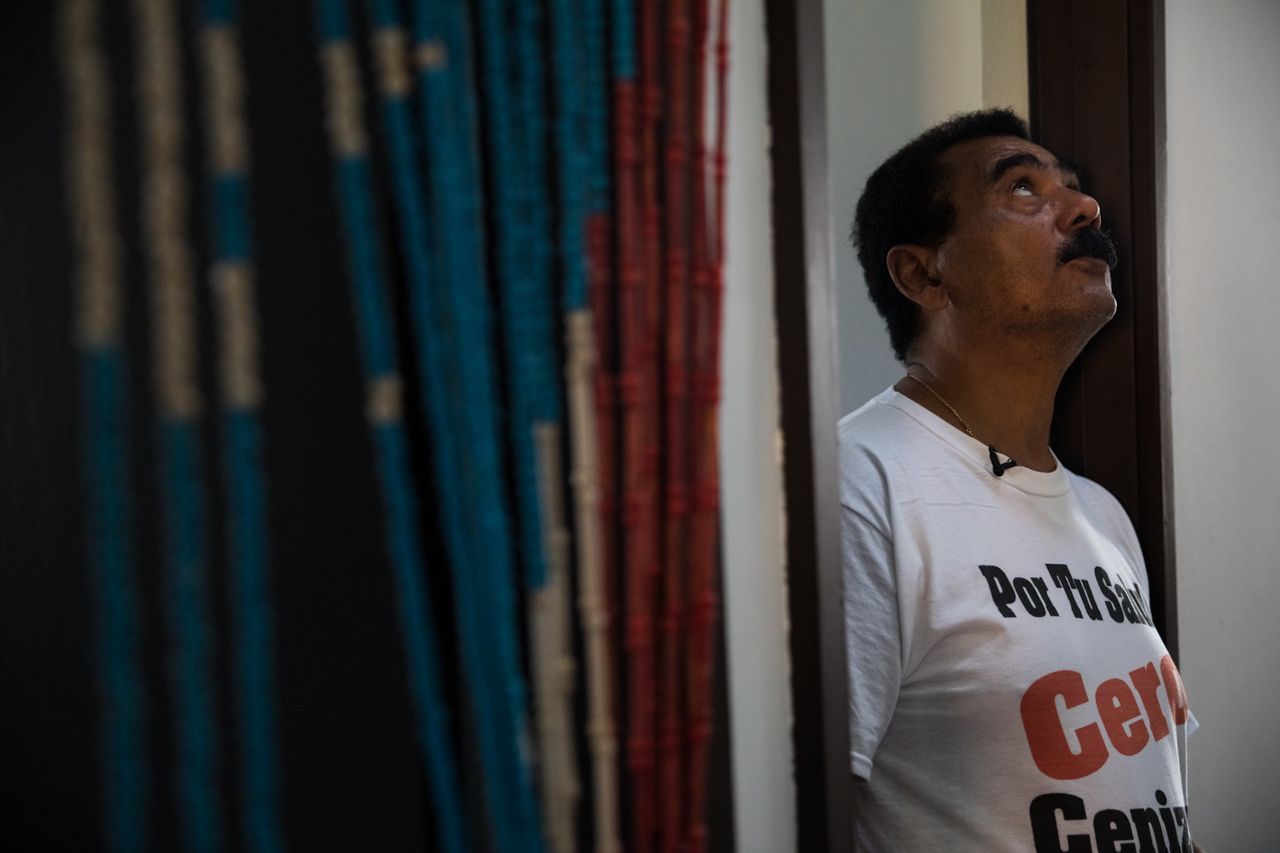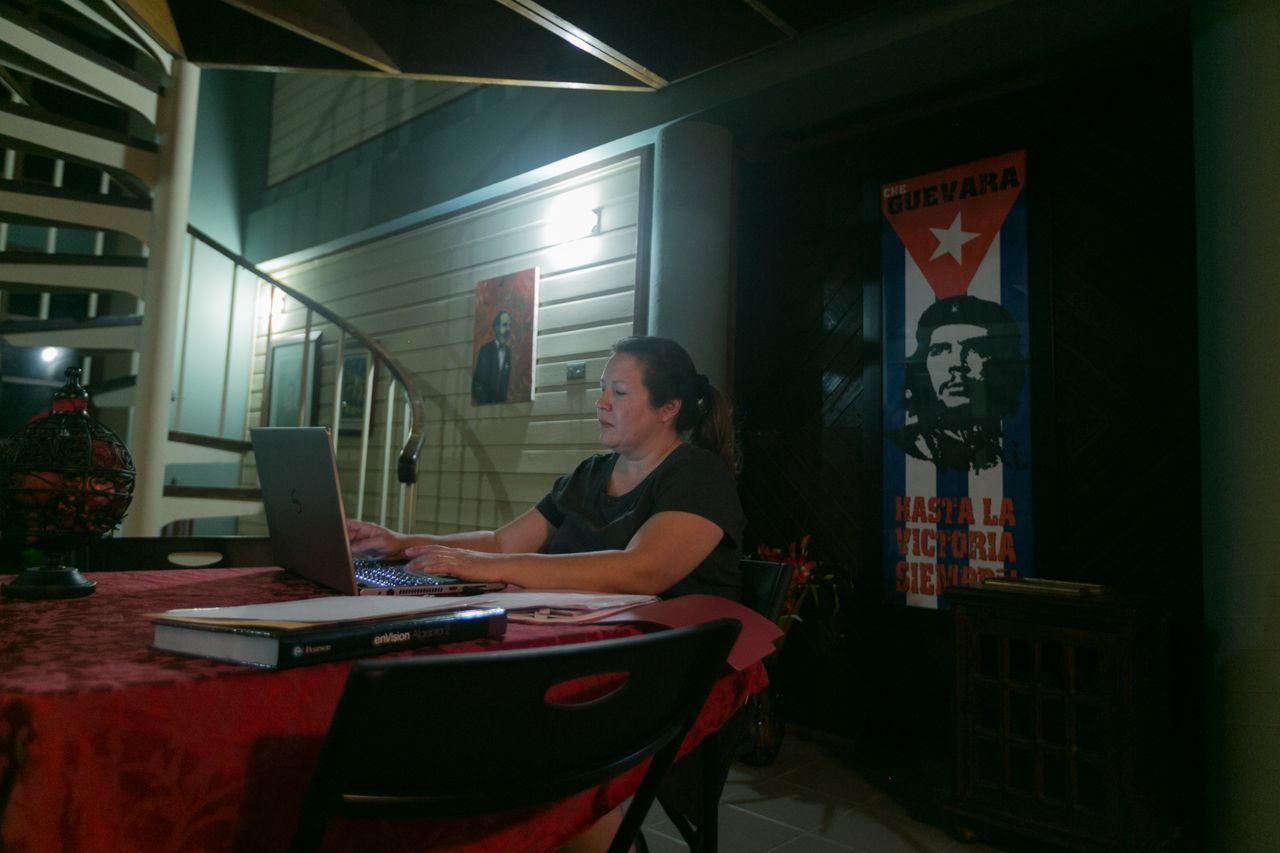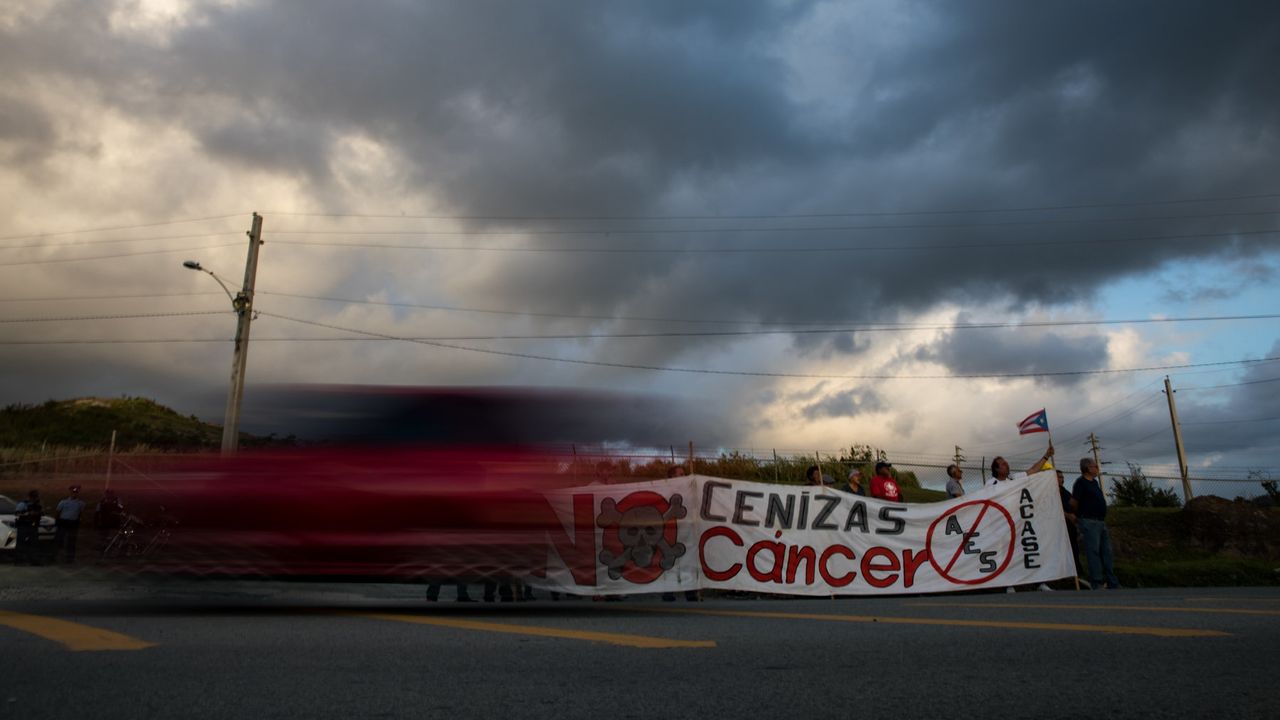HUMACAO, Puerto Rico ― It’s 7 a.m. on a Monday, but already 19 people are at the gates of the El Coquí landfill to protest disposal of coal ash. Five of them, including Carmelo García, have been here since before dawn.
Some protesters wear white T-shirts that say “For Your Health, Zero Ashes” in Spanish, while others hold a banner that reads,“No Ash Cancer.” Nine police officers and company security guards watch the protest from behind.
The landfill in Humacao belongs to EC Waste, a waste management company, and already contains 7,000 tons of coal ash — the byproduct of burning coal for electricity. It is one of several coal ash deposits across Puerto Rico, and the ash is shipped here from a coal-fired power plant in Guayama, about 37 miles away. Applied Energy Systems (AES), the plant’s owner, also stores a five-story pile of ash on-site.
Between 2004 and 2011, the AES plant converted 2 million tons of ash into filler for the construction of housing developments across Puerto Rico, according to the Centro de Periodismo Investigativo, a Puerto Rican nonprofit investigative journalism center. The plant has sent an estimated 400,000 tons of ash to landfills in Humacao and Peñuelas, while another 1.1 million tons of ash are unaccounted for, widely assumed to have been deposited in other areas of the island.
The U.S. Environmental Protection Agency has found that coal ash contains arsenic, boron, chloride and chromium, all of which have negative health effects. That ash residue can leach into groundwater and soil, and breathing the dust can cause respiratory issues.

Exposure to the chemicals in coal ash has been linked to bladder, stomach, skin, lung and kidney cancers, asthma, emphysema and infertility, according to a 2010 study by Physicians for Social Responsibility. The ash is also radioactive, and long-term exposure to radiation can result in cancer and genetic issues according to the EPA.
Many of the protesters gathered at the Humacao landfill on this balmy morning say they’ve already seen these health effects in their friends and relatives.
“To the administration of EC Waste, we’re saying that these ashes can’t be there, more ashes can’t come out, because they contaminate and sicken everyone,” said Timmy Boyle, spokesman for the Alianza Comunitaria Ambiental del Sureste (ACASE), speaking into a makeshift speaker system from the top of a red pickup truck.
It’s been more than a year since new coal ash was dumped in the landfill, but ACASE believes the dumping may resume soon as the island’s coal-burning plant returns to its level of energy generation pre-Hurricane María. They want to stop the dumping before it starts again, and are demanding the closure of the plant and an end to ash deposits on the island.
“En contra a las cenizas, el pueblo se moviliza!” they chant: “Against the ashes, the people mobilize!
Buried In The Ash
When María made landfall in Puerto Rico on Sept. 20 last year, it destroyed the island’s power grid, rendering the AES plant in Guayama, the island’s sole coal-burning power plant, inoperable for five days.
Though the Puerto Rican Board of Environmental Quality ordered AES to cover its ash piles before the hurricane, it did not. The largest ash piles, in Guayama and Peñuelas, lost meters of ash in the storm, and ashes floated free all over the island, turning the air gray and contaminating the groundwater with heavy metals and radioactivity, according to the newspaper El Nuevo Día and a study for AES released earlier this year. AES could face fines of up to $75,000 for failing to cover the ash, according to El Nuevo Dia, but there has been little update since.
While the storm brought new attention to the coal ash here, the movement against it is much older. AES sent 57,000 tons of ash to the Dominican Republic between 2003 and 2004 until residents there filed a lawsuit to stop it in 2009 over concerns about miscarriages and birth defects, according to the Centro de Periodismo Investigativo. AES now primarily deposits its ash in Puerto Rico, though the newspaper La Perla reported in April that the company is shipping to an undisclosed amount to Jacksonville, Florida.

The Puerto Rican legislature approved a new law in July 2017 prohibiting the disposal of coal ash on the island and giving local plant operators 180 days after production to remove the ash. The law allows for the ash to be turned into cement or designated for another commercially beneficial use.
But many in Puerto Rico say the new law is ineffective, largely because AES does not consider its coal combustion residuals to be coal ash. It’s a mix of ash and water they call “AGREMAX” that can be used in construction — a classification that has resulted in the continued storage of thousands of tons of coal ash on the island.
The EPA also issued new rules for coal ash disposal in December 2014 that called for the closure of impoundments and landfills that don’t comply with engineering and structural standards. But the new rule classified coal ash as non-hazardous industrial solid waste and left enforcement largely up to states and local governments.
For Puerto Rican activists, the storm has reinvigorated concerns about how coal ash will be handled on the island going forward, and they are putting pressure on the government to find a solution.
Taking A Stand
Yanina Moreno stands at the fence outside the AES plant in Guayama with her camera, documenting the change in the ash pile adjacent to the plant. She came here with her family after the storms, she said, and saw the pile was significantly smaller, the ash likely scattered in the winds.
On a Sunday in March, she and two activists from the group Comunidad Guayamesa Unidos por tu Salud take pictures from the public road outside the plant and discuss the issues the ash has caused them. Their conversation pauses as a security van pulls up alongside them and slowly passes the group. Its driver radios for backup, and moments later, two employees in AES jumpsuits arrive to confront the activists.

The three say they aren’t doing anything illegal, but an argument ensues. Moreno records it all on her phone. This has happened every time she has come to take photos and videos of the plant. She believes AES keeps track of the people who approach their property and pays special attention to the protesters.
Moreno is the spokeswoman for Campamento Contra Cenizas de Carbón, a group based near the Peñuelas Valley Landfill that has also been receiving ash from the AES plant since 2015.
The group has been protesting the dumping of ash since the beginning, but Hurricane María increased the group’s concerns about contamination. Between July and August 2017, 709 new truckloads of ash were brought to Peñuelas ― 12,000 tons of coal ash, according to the local press.
The Peñuelas community didn’t know about the new deposits brought in last summer, Moreno said, but figured it out when they saw trucks heading toward the landfill, ash flying behind them. Residents began to notice a persistent, fine layer of black dust coating their floors, furniture and yards.
“The cleaning was so continuous,” Moreno said. “You would see glass tables with this layer of dust.”
They worry the ash was spread further during the hurricane.
Over the past five decades, Peñuelas has also been home to petrochemical and petroleum plants and incinerators, said Moreno, so pollution isn’t new here. But the coal ash is the most recent, and possibly the most dangerous.
“We are in a zone that has been highly contaminated,” she said.
Six of her neighbors died of cancer and respiratory illnesses in a span of just three weeks last summer, she said. Moreno and other protesters suspect the ash is making people sick in a town that has the third-highest rate of cancer on the island, according to the Cancer Register of Puerto Rico.
Moreno said the government refuses to acknowledge the community’s health problems as a consequence of the ash and has not yet conducted the health studies in the area that her group has demanded.
“Our worry is to not keep paying the consequences, to not keep bringing other industries, other contaminants that aggravate the situation,” she said. “Because then our community will disappear.”
The Detrimental Impact Of Coal Ash
Carmelo García, a member of ACASE who lives less than five miles from the EC Waste landfill in Humacao, believes his group’s activism has helped prevent new ash from being dumped there for nearly a year. Hurricane María drastically changed the landscape for the movement.
As of March, García had not had electricity in six months. He and his wife were running a generator for three hours every morning and evening to sustain their home. But García has still been active in coal ash protests in his town.
He said he started protesting coal ash pollution five years ago when he noticed his grandmother’s asthma worsening after trucks carrying the ash started passing through his hometown of Maunabo. His scientific and chemical background — he has a doctorate in chemistry and teaches at the University of Puerto Rico at Humacao — led him to investigate why his grandmother was getting sicker when everything else in her life was constant. He began to suspect the ashes were affecting her lungs.
The more research he did, the more concerned he became.
“As soon as I sat down and read some of the pages, I said, ‘Oh my God, this is a criminal thing they are doing. This is a time bomb,’” he said. “The only option was to join the movement and to help them.”
Now García wants to communicate the dangers of coal ash to people affected by the landfills and the transportation of coal ash.
“Here at stake is the very life of the people living not only in Guayama, Peñuelas and Humacao,” he said. “Here at stake is the life of the people living on the island, because this is not a big island.”
García said the landfills are not equipped to contain the ash during hurricanes. And while the storm slowed coal-burning on the island for months, he worries the drive to dump will resume.
“We know (that) as soon as the grid is up, they are planning to start burning like hell, and we will start getting not only the ashes they produce but the ashes they already had,” he said. “And we are talking here thousands and thousands of tons of ashes.”
A Demand For Accountability And Change
Under a tent in front of the capitol in San Juan in the early afternoon of March 15, protesters and journalists mingle among pictures of the Guayama landfill at one of the first coal ash protests since the storm. There’s a giant banner highlighting the communities in Puerto Rico affected by coal ash that reads: “CONTAMINATED WITH ASH.”
Protest groups from across southeast Puerto Rico are there, including Campamento Contra Cenizas de Carbón and ACASE. The air thrums with a sense of urgency. A few days before, news had broken about the presence of chemicals and radioactive materials in groundwater near the AES plant in Guayama — evidence, they feared, that the coal ash was leaching these chemicals into the environment.

Miriam Gallardo Gonzalez of the Frente Afirmación Sureste (FAST), a group based in Guayama, gave an emotional speech about miscarriages and animals born with defects in her community — both caused by the ash, she said.
“The problem of the ashes is real,” she said.
The groups had penned a letter with a list of demands and to deliver to Senate President Thomas Rivera Schatz.
“We are demanding, among other things, first that the Department of Health and the Board of Environmental Quality intervene immediately in the contamination,” said Víctor Alvarado, the spokeswoman for the Comité Diálogo Ambiental de Salinas, an environmental advocacy group from Salinas, a town along the path the ash trucks took from Guayama to Peñuelas.
The protesters want the state to classify coal ash as a hazardous waste, change the way the ash is tested and perform tests for radioactivity. The biggest request, however, was simple: They want the coal plant shut down for good, so no more waste is created.
Photos and video by Aubrey Patti, Darian Woehr, Alexis Fairbanks and Kaitlin Harlow. Graphics by Peyton Chance and Connie Jin. With contributions from University of Puerto Rico student Cristina Arroyo.
